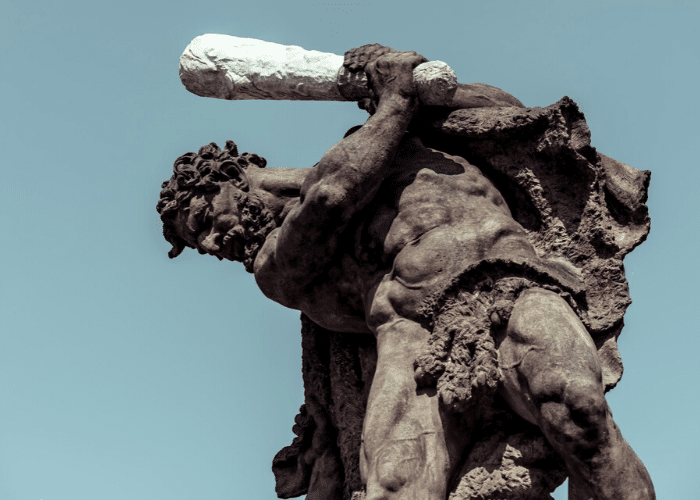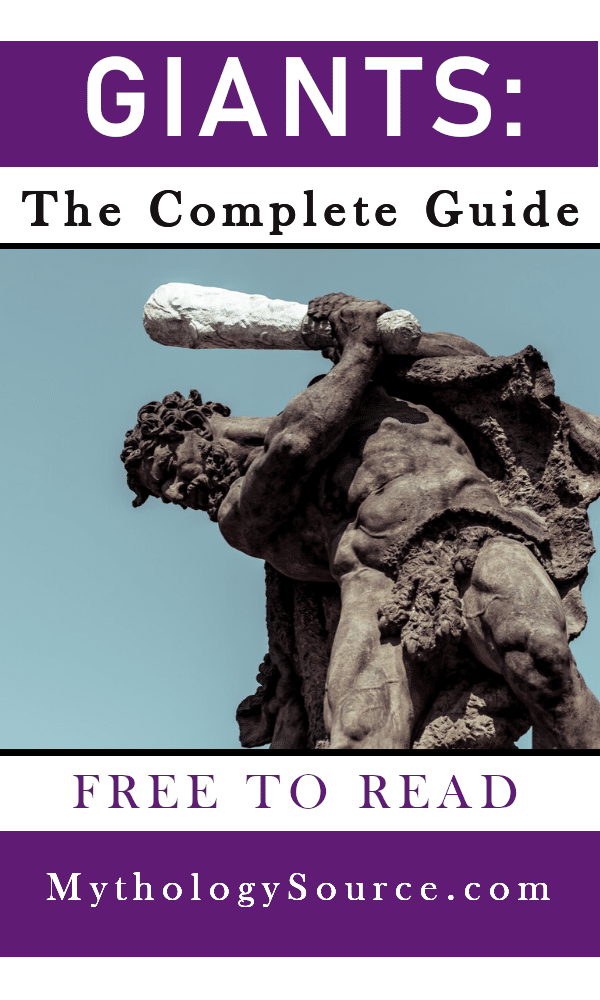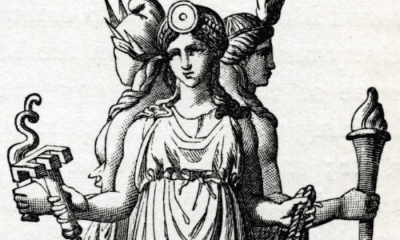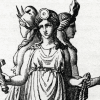
Greek
The Gigantes: The Giants of Greek Mythology
The Gigantes: The Giants of Greek Mythology
Many ancient cultures had myths about Giants, but the Greek giants could be real monsters. Keep reading to find out all about the Gigantes, the giants of ancient Greek legend!
The Greeks were not the only culture to have myths about ancient races of enormous men. The Norse, for example, are famous for their Giants.
The Greeks, however, believed in many different kings of Giants, and some were truly terrible.
The Gigantes, as the Greeks called them, did not all share a common ancestry. They had many different traits and personalities.
Some were on friendly terms with the gods, even aiding them in times of war. Others, however, were fearsome enemies.
The only thing the different types of Greek Giants had in common was their amazing size. Even in that, however, some Giants were greater than others.
The First Giants
There were many generations of beings in Greek mythology that could be classified as giants.
The first of these were among the children of Gaia and Uranus.
While the Titans were usually said to be larger in form than the later gods, and much larger than men, the Greeks made a distinction between large gods and true giants. The siblings of the Titans, however, were giants.
Gaia gave birth to six children with Uranus other than the mighty Titans. Her other sons were considered monsters by their father and were the first six giants.
The three Hecatonchieres were monstrous beings with a hundred hands each. The three Cyclopes were giants with a single eye each.
Uranus was displeased with these six monsters and hid them away. He buried them deep within Gaia herself, where she could not see them but could feel them clawing away at her.
The imprisonment of the Hecatonchieres and Cyclopes would lead Gaia to urge the Titans into rebellion. The mother earth would do whatever it took to have her children set free.
It would, in fact, take two rebellions to set the giants free. Zeus would finally release them as allies in his fight against his own father.
With Gaia’s help, Zeus and his allies found the giants she had borne with Uranus and freed them. With six strong new allies, the balance of power shifted to give the younger gods the upper hand.
The Hecatonchieres were strong fighters. With three hundred hands between them, they were able to continuously throw boulders at the Titan forces to break their ranks.
The Cyclopes, meanwhile, had become skilled artisans, displaying a level of intelligence and ingenuity that was not seen in many later giants. They presented Zeus and his brothers with amazingly powerful gifts to help them win the Titanomachy.
Hades received a helmet that granted the power of invisibility. Poseidon was given his trident, a powerful weapon that could summon earthquakes and tidal waves to destroy entire lands.
Zeus, in the meantime, was given the most powerful gift of all. The Cyclopes had crafted the thunderbolts that would become his defining weapon.
The first giants proved themselves to be strong and valuable allies to the gods of Mount Olympus. After the war was won, the Hecatonchieres were made the wardens of the Titans’ prison in Tartarus.
Unfortunately for Zeus and the Olympians, not all giants would be such great allies.
The Earth-Born
While the Titans still ruled, Gaia had given birth to another race of giants.
The Hecatonchieres and Cyclops had been born when she and Uranus were together. When he was forced away from her, however, he still managed to father more children.
When Uranus was emasculated by his son, his blood spilled onto the ground below. His last children would be born from these drops of blood.
Among the many terrible beings born from his blood were the Gigantes. This second race of giants became the defining one for how giants were seen in Greek mythology.
The one hundred giants this way were born fighters, created from their father’s blood and the horror of his son’s betrayal. They were depicted either as armored soldiers or as a savage barbarian horde dressed in skins and fur.
Often they were shown with serpent’s tails instead of legs or describes as having snakes in their hair. The inclusion of snake-like features was a common way for Greek artists to show a being as malevolent or evil.
As the Olympian gods took power, the Gigantes were already causing problems. They abused and tormented the smaller race of humans, using their size and superior strength to steal food and destroy human settlements.
The gods of Mount Olympus would not fight these giants because of their crimes, however. Once again, the war would be spurred by Gaia.
The War of the Giants
While the Cyclopes and Hecatonchieres had been freed, Gaia had paid a price for them. Most of the Titans had been imprisoned in Tartarus at the end of the Titanomachy.
Once again Gaia’s children were imprisoned, and once again the solution she thought of was to send a new power to challenge the ruling gods.
This time, she sent the Gigantes against the gods of Mount Olympus.
The Gigantomachy was the second great war fought by the gods of Olympus. It would be a much shorter conflict, however.
The Titans and Olympians had been evenly matched, making the war drag out for ten years. The fight against the Gigantes was much easier.
The gods seemed to have little trouble defeating the giants. According to later myths, however, they had help.
The gods had a prophecy among themselves that the leaders of the giants, Porphyrion and Alcyoneus, could only be killed when they were away from their homeland. Additionally, the gods would not be able to kill them without the help of a mortal.
When Gaia heard this she sent the Giants in search of an herb that would guard them against any harm done by a human. Zeus ordered Eos, Selene, and Helios to all hide their light, however, so the giants could not find the protective herb.
Porphyrion and Alcyoneus had already left their homeland when they went to war, but Zeus needed a mortal ally to help him win. He called upon his son Heracles, who had not yet ascended to the heavens as a god himself.
With the help of the great hero, the gods were able to easily defeat their foes. Only one of the giants escaped alive, having been turned into a dung beetle by Gaia to hide him.
The addition of Heracles to the tale is almost certainly a later one. The timeline of Greek creation and succession is often hazy, but the inclusion of the great hero so early in the rule of the Olympians seems at odds with the genealogies and eras given elsewhere in mythology.
By the time of the Roman Empire, belief in the Gigantomachy had faded. Roman writers seemed to have seen the story as an absurd legend rather than a historical fact.
As evidenced by some text, though, they still had no doubt that the Gigantes were real:
Now I admit that Gigantes (Giants) have existed, and that gigantic bodies are revealed all over earth when tombs are broken open; nevertheless I deny that they ever came into conflict with the gods; at the most they violated their temples and statues, and to suppose that hey scaled the heaven and chased away the gods therefrom,–this it is madness to relate and madness to believe.
-Philostratus, Life of Apollonius of Tyana 5. 16 (trans. Conybeare)
Friends of the Gods
With the Gigantes wiped out, there were no other giants who posed a real threat to the Olympians. The few antagonistic giants that remained were solitary and weakened, making them relatively easy for a god or hero to defeat.
In fact, some giants became great friends and allies of the Olympians.
Some of these were the children of the gods and remaining Titans, who were occasionally born as giants instead of gods or demigods. Others were children of the other primordial gods, separate from the children of Gaia and Uranus.
The giants who were mentioned as allies of the gods included:
- Argos – Often given the surname Panoptes, Argos was a servant of Hera. He was killed by Hermes while standing guard over Io, the first death among the Olympians.
- The Younger Cyclopes – While Polyphemus was cannibalistic and lacked the intelligence of the Elder Cyclopes, he and his brothers were sons of Poseidon. Their father came to their aid and declared Odysseus his enemy when Polyphemus was blinded.
- Damasen – A Lydian giant who killed a dragon that was destroying human settlements in the region.
- Orion – A hunting companion of Artemis, various reasons were given for his execution. He was honored enough to be placed in the stars as a constellation, however.
- The Sons of the Cyclopes – The sons of the three original Cyclopes were friends of Zeus. They were killed by Apollo as revenge for Zeus’s smiting of his own son Asclepius. Apollo was temporarily banished from Olympus for the crime.
- Hoplodamus – Although not mentioned among the gods of Olympus, he had aided Rhea when she hid the infant Zeus.
- The Hyperborean Giants – The sons of the wind god Boreas, they served as priests in the legendary realm of eternal spring.
- The Curetes – These giants, one of whom may have been Olympos, protected and mentored Zeus when he was a child in hiding.
The Giant Typhon
Gaia’s children had not prevailed against the Olympians, but she had one more son she could send to try to end Zeus’s rule and ensure freedom for all her offspring.
Typhon was not one of the Gigantes. He was a child of Gaia and Tartarus and the most terrible of all her sons.
He was larger than even the greatest giant, standing so tall that his head scraped against the clouds. The huge wings on his back could stir up winds so strong that they would destroy anything in their path.
Instead of humanoid legs he had two coiled serpents’ tails. Snakes also grew from his one hundred hands in place of fingers and rose in coils from around his shoulders and waist.
The great Typhon had one hundred heads. Only one was that of a man; the others were every type of beast and monster known in the world.
Each of his many mouths breathed fire. He heated rocks until they glowed red hot so he could throw them at his enemies, each of his one hundred hands tossing fiery boulders in a different direction.
There are many versions of the battle between Zeus and Typhon. In one, even Gaia’s most terrible giant son is no match for the new king of the gods and Zeus easily defeats him.
In another, however, Zeus is taken by surprise and almost killed. Typhon stole both his thunderbolts and the sinews from his legs, forcing the gods of Olympus to flee to Egypt.
Only the rustic god Pan and Cadmus stayed behind. They devised a plan to trick the horrible giant and rescue the king of the gods.
Cadmus disguised himself as a shepherd playing music on his flute. Typhon was entranced by the music’s spell and challenged Cadmus to a music contest.
Cadmus argued that he needed a lyre to play properly, but he had no sinews to string one. Under the power of the magical song, Typhon agreed to use Zeus’s sinews for the lyre.
With Typhon distracted, Zeus was able to crawl to the place where he had left the thunderbolts. Pan and Cadmus stole back his sinews and restored him so he could fight again.
Typhon was so angry at the deception that he rampaged around the earth, burning trees and killing most of the animals. Seas and rivers were boiled away and fertile land reduced to dust and sand.
By morning Zeus was healthy enough to fight again. The battle was enormous and destructive but eventually Zeus was able to wear the storm giant down and defeat him.
With the defeat of Typhon, Zeus secured his throne on Olympus once and for all. The gods returned and never again faced such a major threat to their rule.
Gaia was done sending her giant children to challenge the rule of Olympus. She had lost too many children in her attempts and decided to focus on protecting life instead of risking further death.
The Origins of Volcanos and Earthquakes
Like many of the early legends of the ancient world, myths of the Giants helped to explain natural phenomena and features of the world the people experienced.
The legends of the Gigantomachy ended with the burial of the defeated Gigantes under the surface of the earth. Although dead, they sometimes rolled and shifted within their mother’s earth.
This story provided a simplistic explanation for earthquakes. The movement of the Giants explained the frequent and unpredictable seismic activity of the Mediterranean region.
A similar story involving Typhon explained the area’s most active volcano. The fire-breathing Giant monster was said to have been entombed beneath Mount Etna, and its eruptions were the remnants of his terrible, hot breath.
The story of Typhon also explained the geography of several places around the Mediterranean. The rampage that burned swathes of the earth was used to explain the formation of dry deserts in North Africa and the Near East.
One popular theory was that the Giants of Greece, and those of other cultures, were invented to explain abnormally large bones sometimes found in caves and beneath the earth. While we recognize them today as belonging to large prehistoric animals, giant humans helped the people of the ancient world explain the existence of bones that were too large for any animal they had encountered before.
In fact, one largely disputed theory claims that the Cyclopes were inspired by the skulls of extinct mastodons. The large nasal cavities were mistaken for eye sockets, giving rise to the belief in an extinct giant race with a single eye in the middle of their heads.
The Giants of Greek Mythology
Like many other ancient cultures, the Greeks had several myths involving Giants.
The first were six children of Gaia, the earth, and Uranus, the heavens. They were the siblings of the Titans but had inhuman features that caused their father to imprison them.
Two generations and two rebellions, Zeus finally freed these first races of Giants. They proved to be excellent allies, using both strength and intelligence to help win the war that gave the Olympians power.
The second generation of Giants, born from the blood of Uranus, was less friendly. They were cruel and barbaric.
Gaia urged them into war against the gods, but they Gigantes were soundly defeated. Their bodies were buried and became the cause of earthquakes.
The last foe Gaia sent against Zeus and his kin was the terrible fire-breathing Typhon. This giant was almost able to defeat Zeus, but cunning won the day.
Typhon explained the volcanism of Mount Etna and the dry, scorched lands of desert countries.
The few antagonistic Giants who remained were largely isolated and unskilled. They were easily picked off but the gods and heroes.
Many Giants, however, were friendly toward the gods. Some lived and worked with them, even protecting them from harm.




